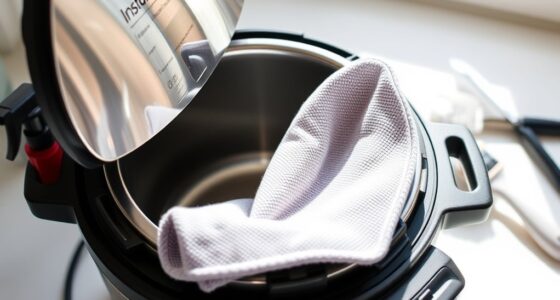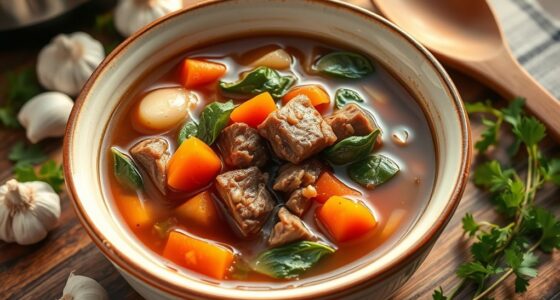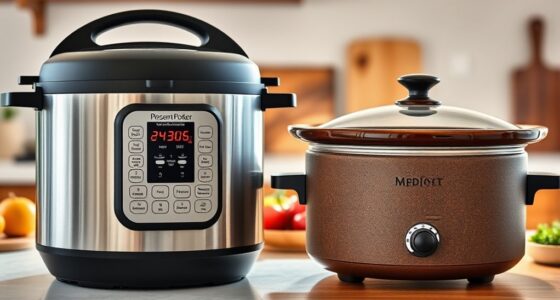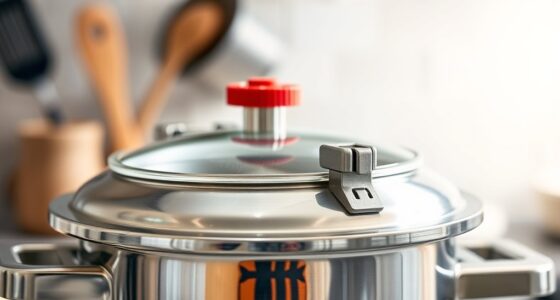Batch cooking grains and beans in a pressure cooker saves you time by preparing large quantities quickly and consistently, making meal prep easier. You can cook versatile ingredients like rice, quinoa, lentils, or black beans in a fraction of the time compared to traditional methods. Once cooked, store them properly in airtight containers and incorporate them into salads, bowls, or tacos throughout the week. Keep going to discover simple tips for perfect results every time.
Key Takeaways
- Use the pressure cooker to cook multiple batches of grains and beans simultaneously for time efficiency.
- Rinse and soak dried beans and grains as needed before cooking to ensure even and thorough results.
- Divide cooked ingredients into portion-sized, airtight containers for easy storage and future meal prep.
- Cool cooked items to room temperature before sealing and refrigerating or freezing to preserve freshness.
- Label stored batches with dates and types to organize and track freshness for quick meal assembly.

Batch cooking grains and beans in a pressure cooker is a smart way to save time and make certain you always have healthy ingredients on hand. When you prepare these staples in advance, you simplify your meal prep strategies, making it easier to put together nutritious meals quickly during busy weekdays. Using a pressure cooker ensures you get perfectly cooked grains and beans in a fraction of the time compared to traditional methods, freeing you up for other tasks or relaxation.
To start, you want to develop effective storage techniques. Once you’ve cooked a large batch, let the grains and beans cool to room temperature before transferring them into airtight containers. Proper storage helps preserve their freshness and prevents spoilage. Divide the cooked ingredients into portions that suit your weekly meal plans, making it convenient to grab what you need without wasting leftovers. Keep these containers in the fridge if you’ll use them within a few days, or freeze them for longer-term storage. Labeling containers with dates guarantees you keep track of freshness and avoid forgetting about older batches.
Incorporating batch-cooked grains and beans into your meals becomes effortless once you implement solid storage techniques. For example, you can toss cooked lentils into salads, stir cooked rice into veggie bowls, or add cooked black beans to tacos and wraps. Having a ready supply means you’re less likely to rely on takeout or processed foods, aligning with your health goals. When you’re meal prepping for the week, consider portioning out servings into individual containers, so you just need to reheat and serve. This not only saves time but also helps control portion sizes and promotes mindful eating.
Your pressure cooker makes this process even more efficient, as it reduces cooking time and ensures consistent results. Experiment with different grains like quinoa, brown rice, or barley, and beans such as chickpeas, kidney beans, or black beans. Once cooked, these versatile ingredients can be stored and incorporated into a variety of dishes, from hearty stews to light salads. Developing a routine around batch cooking and strategic storage means you’ll always have nutritious ingredients ready, saving time and reducing stress, which helps you stay consistent with healthy eating habits.
Frequently Asked Questions
How Long Can Cooked Grains and Beans Be Stored Safely?
You can typically store cooked grains and beans safely for 3 to 4 days in the refrigerator. Make sure to keep them in airtight containers to prevent spoilage. Check for signs like sour smell, slimy texture, or mold before eating. If you’re unsure, it’s best to discard them to avoid foodborne illness. For longer storage, freeze them for up to 3 months.
Can I Freeze Cooked Grains and Beans for Later Use?
Yes, you can freeze cooked grains and beans for later use. To keep them fresh, follow freezing tips like using airtight storage containers or freezer bags to prevent freezer burn. Be sure to let the grains and beans cool completely before freezing. Label your containers with the date, so you use them within 3 to 6 months for ideal flavor and texture. This way, you’ll always have ready-to-use ingredients on hand.
What Are the Best Seasonings to Add During Cooking?
You should add herb combinations like thyme, rosemary, or bay leaves, along with spice blends such as cumin, paprika, or coriander, to amplify flavor during cooking. Toss in garlic or onion powder for extra depth. Adjust seasonings based on your dish—savory, spicy, or herbal. Adding these before cooking guarantees the flavors meld well, giving your grains and beans a delicious, well-rounded taste every time.
How Do I Prevent Grains From Sticking Together?
To prevent grains from sticking together, use soaking techniques like rinsing them thoroughly before cooking. Rinse your grains well to remove excess starch, which causes sticking. After rinsing, add a little oil or butter during cooking to help prevent clumping. Stir the grains gently after cooking and let them sit covered for a few minutes. These tips guarantee your grains stay fluffy and separate, making your meals perfect every time.
Are Pressure Cooker Recipes Adaptable for Dietary Restrictions?
Yes, pressure cooker recipes are adaptable for dietary restrictions. You can easily incorporate gluten-free options and vegan substitutions, like using vegetable broth instead of animal-based stock or adding plant-based protein sources. Just keep an eye on ingredient labels and cooking times. Adjust seasonings and components to suit your needs, ensuring the dish remains flavorful and compliant with your dietary requirements.
Conclusion
Now, imagine a busy week where your pantry is stocked with perfectly cooked grains and beans, ready to turn into nourishing meals, while your pressure cooker quietly does the heavy lifting. It’s like having a reliable kitchen assistant that’s both efficient and discreet. With this simple method, you’ll save time and reduce stress, transforming raw ingredients into wholesome dishes effortlessly. Your kitchen becomes a space of calm convenience amid the chaos of daily life.









